Breakthrough of the 6 of the German army to the northern outskirts of Stalingrad
After Stalingrad could not be taken in stride, the German command again changed the plan of the offensive of its troops in the city, pulled in fresh troops and regrouped. The Germans planned to deliver simultaneously two blows in convergent directions - from the northwest and southwest from Stalingrad. The northern group (6th Army) was supposed to seize the bridgeheads in the small bend of the Don in the area of Vertyachy and advance in the direction of Stalingrad from the north-west. Southern Group (4th tank army) struck from the region of Plodovitoye, Abganerovo along the railway to the north, where the troops of the 64th and 57th armies held the defense on the enemy’s path to Stalingrad. To ensure the junction between the two advancing strike groups, the German command also planned to strike east from Kalach. In total, up to 20 divisions were involved for the attack on Stalingrad.
The left flank of the German 4 tank army was provided by two Romanian divisions. The 12 Tank and 24 Infantry Divisions from the 297 Army were transferred to the 6 August Army. The southern strike force consisted of 6 infantry, 2 tank and 1 motorized divisions. The German command also strengthened the northern grouping at the expense of the 8 of the Italian army that had arrived in the Stalingrad sector. Italian troops moved to the Don on the area from Pavlovsk to the mouth of the river. Hopper, replacing the divisions of the 29 Army Corps that were here. However, not very much believing in the combat capability of their allies, the German command of the two divisions of the 29 Army Corps two included in the Italian army (62 and 294 infantry divisions) and one (336 infantry division) transferred to 2 Hungarian Army The 6 Army Strike Force now consisted of 6 infantry, 2 motorized and 1 tank divisions.
Tippelskirch noted: “During August, the 8-I Italian army, consisting of six infantry and one cavalry division, approached the Don and replaced the German troops on the front between the western flank of the 6-th army and New Kalitva. The Italians sided with the 2 of the Hungarian army, which was located upstream of the Don to the 2 of the German field army. ”
The order of the commander of 6 of the German army said: "... 6-I army has the task to seize the isthmus between the Volga and the Don to the north of the Kalach railway, Stalingrad ... For this, the army forces the Don on the front of Peskovatka, Trekhostrovskaya, having main forces on both sides of the Vertyachi . Later, securing herself from counterattacks from the north, she strikes with the main forces through a chain of hills between r. Rossoshka and runoff p. B. Root and goes to the area north of Stalingrad, and part of the forces penetrates into the city from the north-west and seizes it ”. South-west of Stalingrad they planned to "unite with the mobile units of the neighboring army advancing from the south," that is, the 4 tank army.
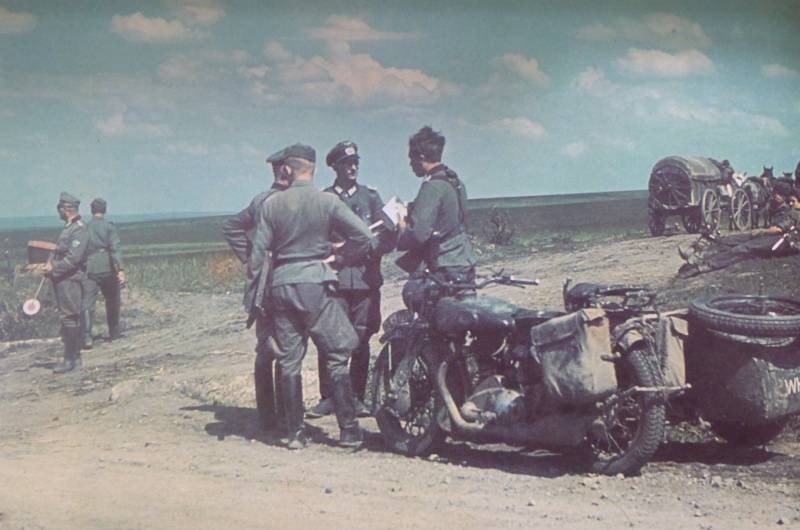
Officers of the German 6-th army confer at the motorcycle NSU 601 OSL at the intersection of field roads during the attack on Stalingrad
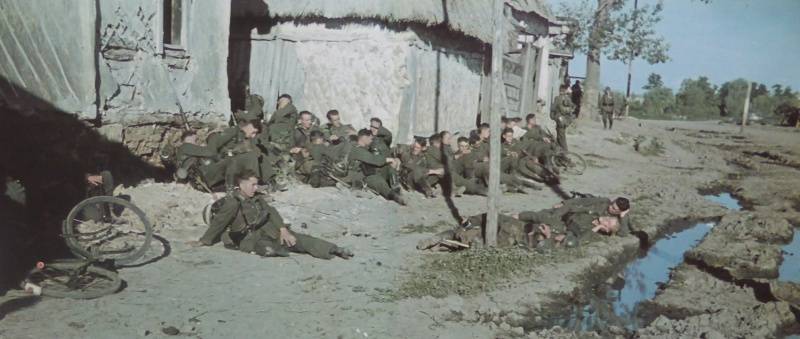
Soldiers of the 578 Infantry Regiment of the Wehrmacht on a halt during the attack on Stalingrad. Photo source: http://waralbum.ru/
Thus, the enemy carried out a new regrouping of forces, pulled up new troops and prepared for a new offensive. The Wehrmacht’s attack forces, which were concentrated in narrow sections on the flanks of the front, were very strong. They numbered about 210 thousand soldiers, more 2700 guns and mortars and more 600 tanks. On the direction of the main blow, the Germans had almost one-and-a-half superiority in manpower, double - in the guns and mortars, and multiple - in the tanks. To support the advance of the ground forces, the 4 th air fleet was recruited, including more than 1000 aircraft. Total 6-I field and 4-I tank German army, 8-I Italian army numbered about 39 divisions (more than 585 thousand people), 7400 guns and mortars, more than 1000 tanks and they supported about 1200 aircraft.
Interestingly, in West German historiography, the plan for mastering Stalingrad, set forth in the order of Paulus, is assessed as vicious in its operational basis. So, Hans Dörr considers his main disadvantage to be planning two hits at the same time. Like, it was necessary to deliver one powerful blow. In reality, the main miscalculation of the German plans is the underestimation of the enemy and the overestimation of their strength.
The troops of the Stalingrad Front deployed in the 480-kilometer strip (from Grandma to Lyapichev) were seriously weakened in the last battles. Only the 63, 21 and 1 Guards armies were satisfactorily staffed. The 33-I Guards and 96-rifle divisions that had left the encirclement were undergoing a re-formation, the 23-i tank corps in Stalingrad was completed. The operational density of the defense in the armies was insufficient - from 15 to 40 km per division. The troops of the Southeastern Front, defending the strip (320 km along the front) from Logovskoye to Lake. Sarpa also had insufficient strength and resources. A particularly large shortage of personnel and weapons was in the 64 and 51 armies, which were heavily damaged in previous battles. The operational density of defense in armies ranged from 20 to 50 km per division, which did not allow for the creation of a dense defense. In manpower, the forces were approximately equal (Soviet troops numbered 580 thous. Soldiers and officers), but a serious advantage in favor of the enemy was in guns and mortars (2,2: 1), tanks (4: 1), airplanes (2: 1).
German offensive
19 August 1942 The assault groups of the 6 and 4 tank armies of the enemy (18 divisions) launched an attack on Stalingrad at the same time. In the YuVF zone, the 64 Army reflected the attack of the German 4 Panzer Army in the battles of August and 18. Only in some areas did the enemy press the units of the 19 and 204 divisions. But in general, the defense of the army withstood the blow. Unable to break through the Abganerovo-Stalingrad railway, the enemy moved the direction of the main attack eastward, trying to reach Stalingrad through Krasnoarmeysk, along the Volga. By the end of August 38, the Germans had broken through the defenses on the right flank of the 21 Army, at the sites of the 57 Guards and 15 Rifle Divisions. Here the enemy penetrated into the location of the Soviet troops on 422-10 km.
The army commander, General F. I. Tolbukhin, immediately threw reinforcements at a dangerous area. Then the Germans attacked the 24 and 14 with tank divisions on the left flank of the 64 army. However, our intelligence discovered the enemy maneuver in a timely manner. The 20-I fighter anti-tank artillery brigade, the 186-th and 665-th fighter anti-tank artillery regiments, the 133-I heavy tank brigade were deployed towards the German strike armored group. The enemy failed to break into the southern outskirts of Stalingrad.
The troops of 6 of the German army from 17 of August were engaged in expanding the occupied bridgehead in the area of Vertyachy and Peskovatka. The Germans crushed the forces of the 14 tank corps, followed by infantry divisions. Opponents in this sector were opposed by units of the 98 Infantry Division of Colonel I.F. Barinov, one regiment of the 87 Infantry Division, students of the Ordzhonikidze School, and the artillery group of Major General N. M. Pozharsky. They fought stubbornly, but were not able to eliminate the enemy bridgehead. For several days the Germans concentrated large forces on the bridgehead. The Germans broke through the outer defensive line. Fighting began on the defensive lines of the nearest approaches to the city. By the end of August 22, the bridgehead was extended to 45 km along the front.
The command of the Stalingrad Front attempted to change the situation by counterattacks on the flanks of the 6 of the German army, which was bursting towards Stalingrad. On August 20, the troops of the 63 and 21 armies partly launched an offensive. Having forced the Don, they entered into a fierce struggle with the enemy, trying to expand the occupied bridgehead. By the end of 22 in August, the 197-th, 14-th Guards Rifle Divisions of the 63 Army and the 304-Rifle Division of the 21 Army broke through the enemy's defensive line on the right bank of the Don and forced the Germans to move somewhat away. The second echelon of the 63 Army - the 203 Rifle Division crossed the river by the end of August 24. However, the advancing Soviet troops did not have the strength (powerful mobile units) for the development of success and, having met the stubborn resistance of the enemy, stopped. In addition, there was a shortage of ammunition that had to be shipped across the Don in difficult conditions. The 3 th Guards Cavalry Corps was transferred to the right bank of the Don, but this did not change the situation.
In the center of the Stalingrad front, 22 August launched the attack of the 1-I Guards Army. Three guards divisions — 38, 41, and 40 — were struck in the northern part of the small bend of the Don. But the guard also lacked the strength and resources to break through the enemy defenses. Guards army promised tanks and rocket launchers, but they did not arrive at the beginning of the offensive. Opponent forces 11 th German army corps, 22-th tank division and other parts put up stubborn resistance, put counter-strikes. Guardsmen were able to expand the bridgehead. German troops on this site went on the defensive. Subsequently, the front line at the site of the 1 Guards Army did not change until the Soviet forces launched a counteroffensive in November 1942.
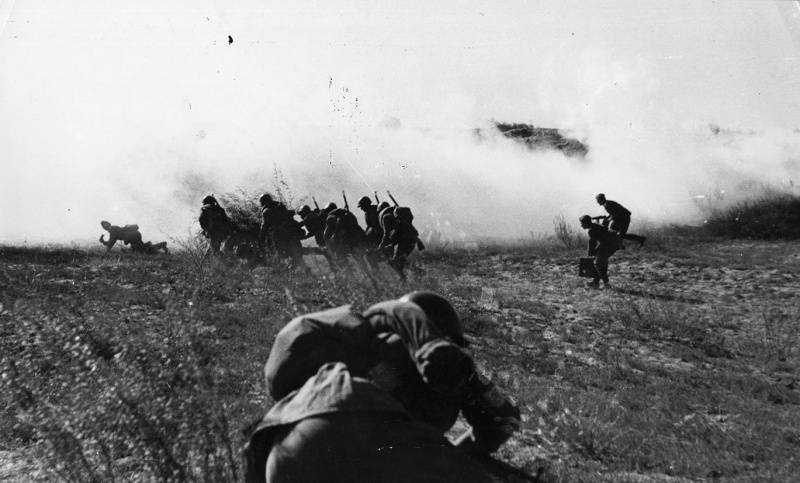
The calculation of the Soviet 45-mm anti-tank gun 53-K changes its position during the battles on the approaches to Stalingrad
Breakthrough of the 6 Army to Stalingrad
The command of the Northern Fleet decided to introduce the main forces of the 87th division into battles on the outer contour in order to destroy the enemy bridgehead. The site, previously occupied by parts of the 87th division on the middle contour, was ordered to occupy the 35th Guards Division. However, the divisions did not manage to arrive at their destination. On the morning of August 23, 1942, German troops launched a powerful offensive. The enemy delivered his main blow back-to-back with the 4th Panzer and 62nd Armies, developing an offensive in the general direction of the Market. “The enemy accompanied the powerful blow of his troops with monstrous blows aviation and artillery. We had neither the strength nor the means to parry the ramming blow of the enemy ”(A. I. Eremenko. Battle of Stalingrad.).
Having broken the resistance of the 98-th division of I. F. Barinov and other troops that were holding up defenses in the area of the bridgehead, the German troops rushed from the Don to the Volga. The regiments of the 87 division of Colonel A. I. Kazartsev moving on the march were on the way to the breakthrough. At first they came under the powerful blow of German aircraft, then the tanks fell upon them. The battle began outside of any defensive line, in open areas. “On the corridor, punched by fascist tanks, motorized infantry moved. The enemy cut Kazartsev’s division in two. How many of his people are on the other side of the corridor, how many fell in battle, the divisional commander did not know. But it was already known that the division no longer had artillery or 120-millimeter mortars, as well as the battalion of communication with all its walkie-talkies. Heavy losses suffered rifle regiments and attached cadets. And if it were not for the march in dismembered order, the losses would probably have been even greater. ”
As a result, the troops of the German shock group crossed all the interfluvial areas and by 16 23 August watches broke out to the Volga near the northern outskirts of Stalingrad, near the villages Latoshinka, Akatovka, Rynok. Following the 16 Panzer Division of the 14 Corps of Gustav von Wietersheim, the enemy’s motorized troops also entered the Volga. German tanks appeared in the area of the Tractor Plant, in 1-1,5 km from factory workshops, and began to bombard it methodically. Following the tanks in the 8-kilometer-long breach, the enemy introduced motorized and several infantry divisions. In the city, alarm battalions and part of the people's militia were raised in alarm.
Thus, the 6-I German army broke through the Soviet defense on the external contour, quickly overcame 60 km and drove a wedge into the battle formations of the troops of the Stalingrad Front, cutting it into two parts. The 63-th, 21-th and 1-th Guards armies were cut off from the 62-th army and the front headquarters, which were located in the area of Stalingrad. The troops operating north of the city (part of the Stalingrad Front) were cut off from the city and the other forces of the Northern Fleet defending Stalingrad and parts of the Southeastern Front. The movement of river vessels on the Volga was paralyzed. The railway lines approaching Stalingrad from the north and northwest were intercepted by the enemy.
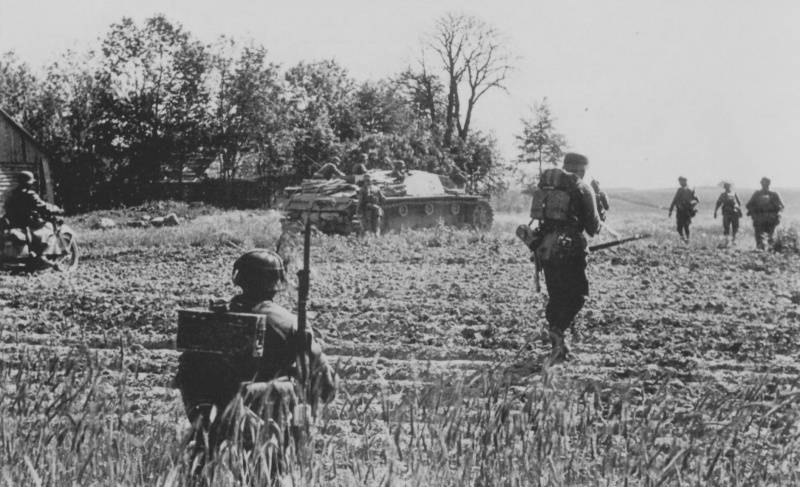
Wehrmacht infantry and self-propelled guns StuG III are moving through the Soviet countryside soon after the Don crossing
Air strike on Stalingrad. City Defense Organization
At the same time, German aviation dealt a powerful blow to Stalingrad. The German command planned to cause panic among the civilian population, to disorganize the defense, and then easily seize the city. The raid of hundreds of aircraft lasted several hours. German bombers flew echelon after echelon, dropping thousands of high-explosive and incendiary bombs. 24 August the Germans continued the bombing of the city. During the day, the German pilots flew around 2 thousands of sorties to Stalingrad. Soviet fighters and anti-aircraft artillery tried to repel the enemy strike. The air attack was repelled by Soviet fighters 105. For one day only 23 August in air battles and anti-aircraft artillery was shot down in the area of Stalingrad 120 enemy aircraft. Residents of the city selflessly tried to save the city from fire.
Industrial enterprises, a river port, oil storages, residential quarters, hospitals and other social infrastructure facilities were destroyed. In the city began strong fires. The flames, which were blown by a strong wind, swept the houses, moving from street to street. Burning oil spilled on the river. The marinas were burning, fire destroyed ships on the Stalingrad roads. The power supply system and city transport were partially damaged. At night, Stalingrad resembled a giant bonfire, the glow of which was visible for many kilometers. A huge blooming city, in which about 600 thousand people lived before the war, was turned into ruins. Thousands of people died and were injured, remained under the rubble, tens of thousands lost their homes. Enemy raids on the city were repeated in the following days unceasingly, completing the destruction of the city. Stalingrad became advanced.
Marshal of the Soviet Union A. M. Vasilevsky recalled: “The morning of the unforgettable tragic of August 23 found me in the troops of the 62nd Army. On this day, the Nazi forces managed to reach the Volga with their tank units and cut off the 62nd Army from the main forces of the Stalingrad Front. Simultaneously with the breakthrough of our defense, the enemy launched a fierce mass bombardment of the city on August 23 and 24, for which almost all the forces of his 4th air force fleet. The city turned into ruins. Telephone and telegraph communications were disrupted, and during August 23 I had to conduct short negotiations twice with the Supreme Commander-in-chief openly on the radio. I could make a detailed report to him about the situation and about our requests late at night on August 24, after the HF telephone connection through the Volga was restored. ”
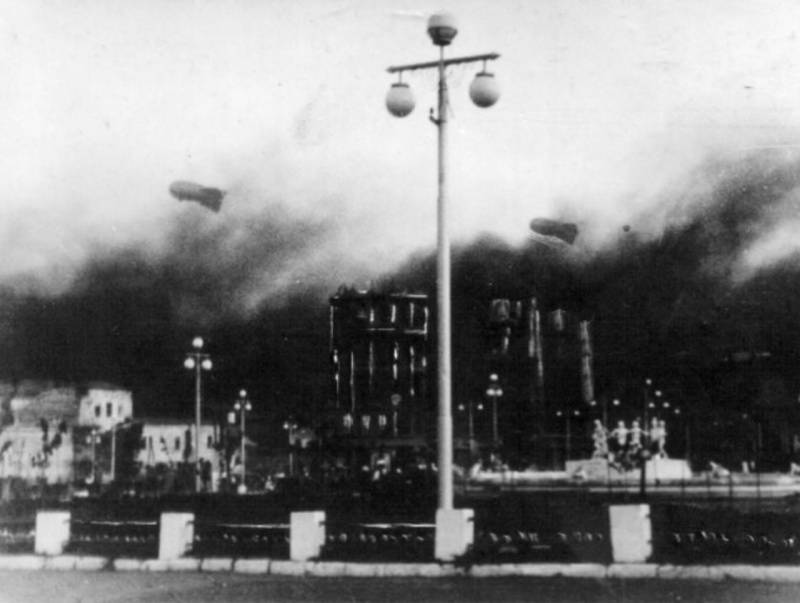
Stalingrad on fire in the area of the station, in the foreground a fountain "Children's dance". In the sky aerostat air barriers
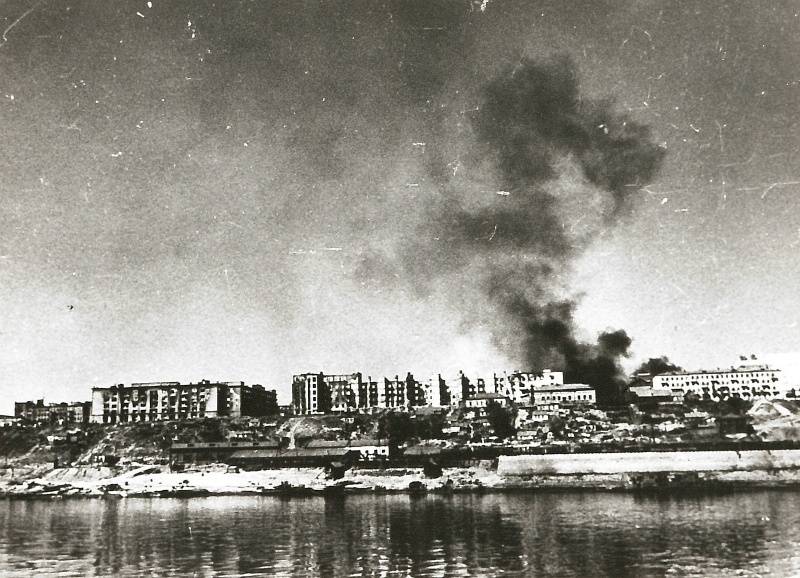
Stalingrad after the German bombing of the city. View from the Volga River
There was a real possibility of the fall of the city. Most of the 62 Army was linked by fighting on the left bank of the Don, a few dozen kilometers from the city. The troops of the 62 Army needed to regroup and occupy new defensive lines in harsh combat conditions. The reserves of the front near the city were few in number: the rifle division, the tank and motorized rifle brigades. But the city was lucky, it was located part of the 23-th and 2-th tank corps under the command of generals A. M. Hasin and A. G. Kravchenko. The 23 Corps was being rebuilt in Stalingrad. Echelons of the 2 tank corps (26-I, 27-I, 148-I tank and 2-I motorized rifle brigades) arrived just before the German breakthrough and were hit by enemy aircraft. The 23 Tank Corps (137, 189, 6 and 6 Guards Tank Brigades) defended the city from the northwest. This made it possible to restrain the fierce onslaught of the enemy and hold out until the time when rifle divisions approached because of the Volga.
To prevent the fall of the city and to organize defense from the west and northwest, the front command mobilized all available forces and means. The city’s defensive line was taken by the soldiers of the 10 division of the NKVD commanded by Colonel A. A. Saraev (the NKVD division had no artillery at all; it was supported by the air defense divisions), cadets of the military-political school, air defense units, the combined marines and other parts of the front line . The division of the NKVD kept the defense on the western outskirts of the city. At the mouth of the river Akhtuba took up the position of a gunboat and an armored boat of the Volga Flotilla.
A particularly dangerous situation was on the northern outskirts of the city, in the area of the Tractor Plant, where the German troops went. Here, the first strike of the enemy was met by units of the 23 tank corps in conjunction with the 2 battalion of the 1077 anti-aircraft artillery regiment, which was in firing positions for air cover of the Tractor Plant. They not only repelled the attacks of the German ground forces, but also were subject to attacks by the Luftwaffe. The 738 th anti-tank artillery regiment, shot from the front of the 57 army, and the consolidated battalion of marines of the Volga military flotilla were transferred here. The city defense committee dispatched parts of the training center for the armored troops troops, the fighter and tank battalions of the militia of the Tractor Plant to the plant area. Turning around on the river Sukhoi Mecheka, these forces covered the northern outskirts of Stalingrad and were the first to fight the enemy that had broken through. The workers of the Tractor Plant supported their 50-60 tanks. Then came part of the national militia and fighter battalions of other areas of the city. By order of the front commander at the Tractor Plant, a combat sector was established under the command of Major General N. V. Fecklenko (Head of the Training and Armored Center of Stalingrad). On the night of August 25 at the turn of the river. The 282 th rifle regiment of the 10 th division of the NKVD troops arrived, which significantly strengthened the forces of the defenders.
At this time, the command took urgent measures to restore the military order. 24 in August north-west of Stalingrad concentrated troops sent from other fronts or from the reserve of the Supreme Command: in the area of Bol. Ivanovki - 16-y tank corps, in the area of Zavarykina - 4-y tank corps and in the area of Mal. Ivanovki - 64-I Rifle Division. At st. Arched, unloaded 173-I, 221-I, 116-I, 24-I and 308-I infantry divisions.
Thus, the threat of the rapid fall of Stalingrad was averted. The German tanks and motorized infantry that had broken through were met by our tankmen, cadets, sailors, NKVD fighters who were supported by the armed militia of the workers of Stalingrad. At this time, the front command and headquarters deployed troops to the Stalingrad area, sent from other fronts or from the reserve of the Supreme Command.
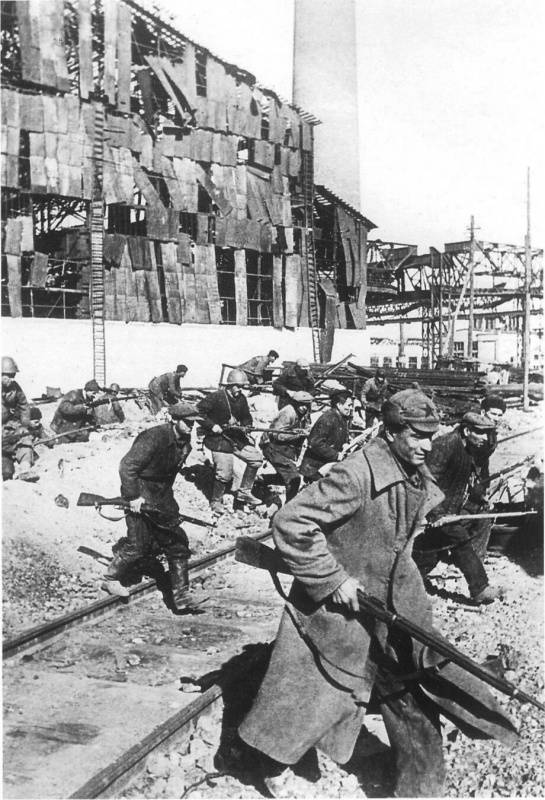
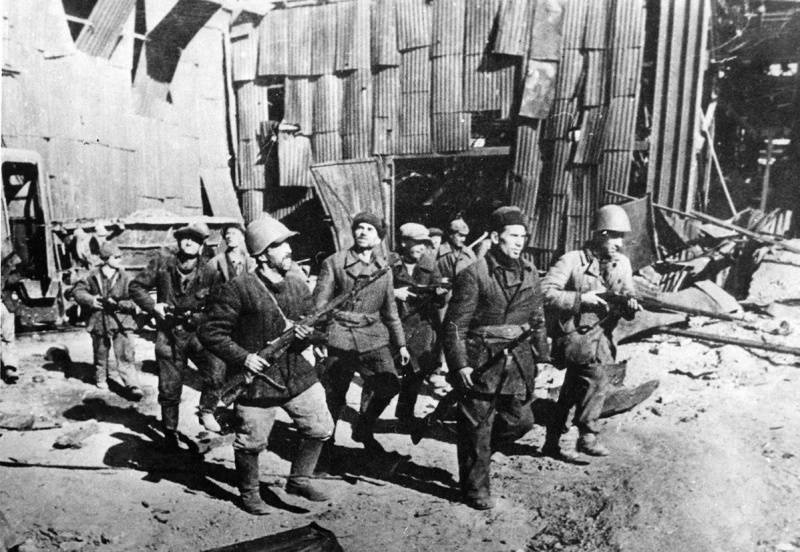
Militias of the Stalingrad Tractor Plant go past the half-ruined workshop to the battlefield
To be continued ...
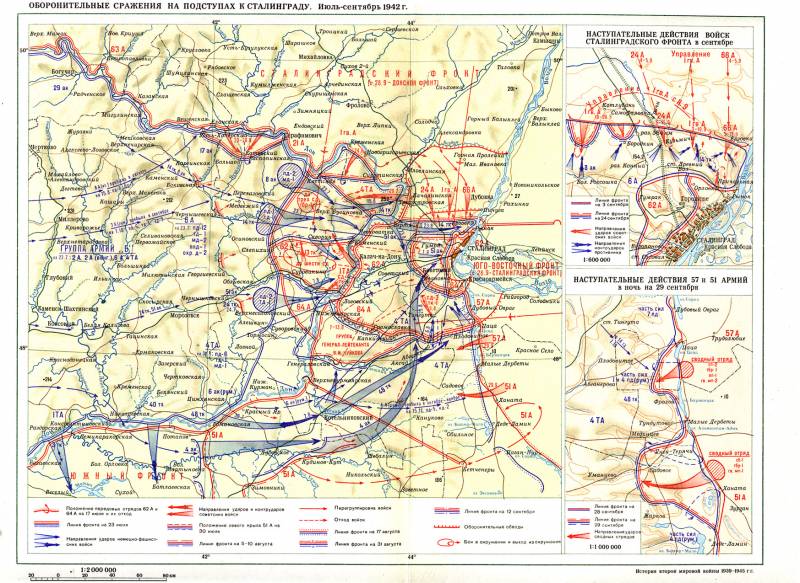
Information